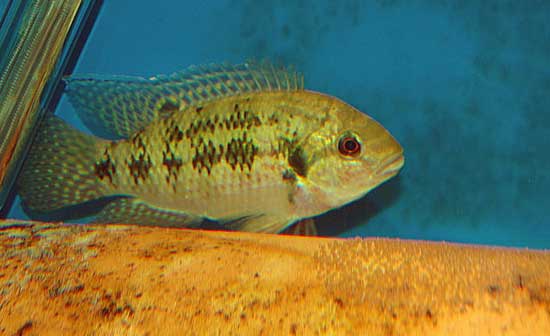Pelmatochromis nigrofasciatus
(Pellegrin, 1900)
Synonyms: Paratilapia dorsalis, Paratilapia longispinnis
Above: A female pelmatochromis nigrofasciatus over eggs. Photo by Rick Borstein.
Etymology:
Genus- Pelma= sole of foot (Greek), chromis= a fish, perhaps a perch (Greek).
Species- nigro= black (Greek), fasciatus= striped (Greek).
Intro:
Pelmatochromis nigrofasciatus is a West African, substrate-spawning cichlid. it is found throughout the central Congo basin from Yangambi to Kinshasa, including the Ruki River, Tshuapa River, Ja River and the Kasaï (Lamboj, 2004). This fish was first typed by Pellegrin in 1900 as Paratilapia nigrofasiciata.
For a bigger cichlid, this fish is not very aggressive. Females with fry, however, will actively defend their brood.
Distribution:
In the wild, Pelmatochromis nigrofasciatus occurs in rivers in the Upper Congo. I could not find details regarding substrate, water temperature/conditions or depth.
Size, Maturity, and Sexual Dimorphism:
Size: Males- 6 inches, Females- 4.5 inches
Maturity: 3.25 inches
Sexual Dimorphism: Males are larger and have much longer fins than the females. Females have a great amount of red in their stomachs and chest, which is quite noticeable during spawning.
Care:
Pelmatochromis nigrofasciatus does not present many difficulties. Provide a large tank (40B or larger), clean water and temperatures of 76 to 78F. Conduct regular partial water changes every two weeks or so.
Pelmatochromis nigrofasciatus is an easy fish to have in a community tank. In large tanks, the fish does well with mild mbuna, haplochromines, and other West African cichlids. They also mix very well with larger tetras and calmer barbs.
Diet:
I fed a variety of foods such as fish Dainichi Veggie Deluxe, Tetra Cichlid Sticks, and New Life Spectrum.
Breeding:
Anton Lamboj's book "The Cichlid Fishes of Western Africa" notes that Pelmatochromis nigrofasciatus requires soft water for spawning. That wasn't my experience. My fish spawned in regular Chicago water— pH 7.4 and 300ppm hardness.
Because Pelmatochromis nigrofasciatus can be a shy fish, I recommend a species tank for breeding. This fish is a substrate spawner, so make sure there are clean rocks or slate for the fish to use as a site to deposit their eggs.
The breeding display is nothing fancy. The male holds his fins up and "dances" over the spawning area, but that is about it. Breeding is typical of most substrate spawners— the female lays an egg or two and the male goes over them and fertilizes them. Up to 500 eggs can be laid in a spawn. The eggs hatch in about four days, and are free swimming three to four days after.
Pelmatochromis nigrofasciatus are good parents when raising the fry with limited pressure. My fish raised the fry to about an inch in length, which was about a month and a half. I don't recommend that you keep them in with the parents this long as it stresses the fish.
Fry grow quickly, and are voracious eaters. As they get older, you gradually see them color up, first with a tilapia spot, then with a stripe, and then they get the golden hue.
Conclusion:
If you are just getting into westies, this is a good fish to keep. It is also nice that you can keep this fish in a community tank with tetras, as this species is non-aggressive.
It is unlikely that you would find Pelmatochromis nigrofasciatus at your local pet store, but tank bred specimens of this fish are becoming more readily available.
References:
- Lamboj, A. (2004). The Cichlid Fishes of Western Africa. Bergit Schmettkamp Verlag, Bornheim, Germany, 255 pp.
- Pellegrin, Jacques. (1900) Poissons nouveaux ou rares du Congo Français. Bulletin du Musée National d'Histoire Naturelle, 6, 348-354.
